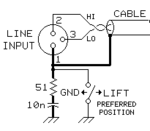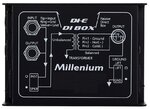Zaaappp
Newbie level 6
- Joined
- Mar 26, 2016
- Messages
- 13
- Helped
- 2
- Reputation
- 4
- Reaction score
- 2
- Trophy points
- 3
- Location
- Florida USA
- Activity points
- 162
Hi All,
I'm assuming the lift sw (when open) causes the "ground" to float some (thus the name "Lift"), and/or decouple a (possible) DC component in the signal?
Can anyone explain what's really going on here, e.g. attempting to eliminate ground loops, and when / why it would be needed ?

- excerpt from a Jensen-Transformer.com https://jensen-transformers.com schematic.
thanks!
- Howard in Florida
I'm assuming the lift sw (when open) causes the "ground" to float some (thus the name "Lift"), and/or decouple a (possible) DC component in the signal?
Can anyone explain what's really going on here, e.g. attempting to eliminate ground loops, and when / why it would be needed ?

- excerpt from a Jensen-Transformer.com https://jensen-transformers.com schematic.
thanks!
- Howard in Florida
Last edited by a moderator:
